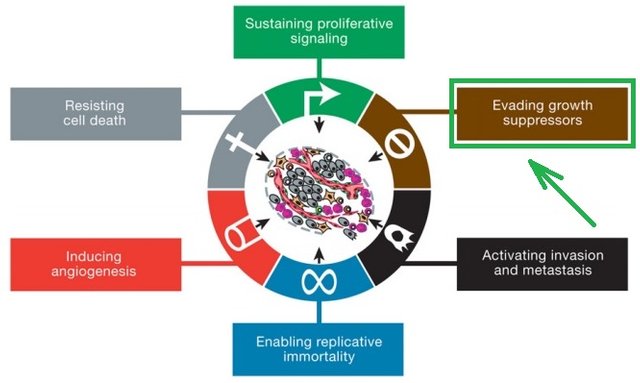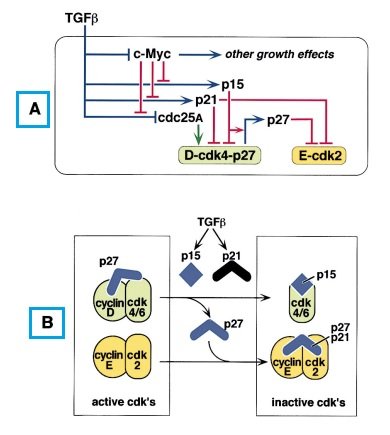Cancer Hallmarks - Evading Growth Suppresors
Hanahan and Weinberg have written two seminal papers about the complexities of cancers. The first one is from 2000 and the second one, an updated version, is from 2011. Together, they have been cited for more than 40,000 times.
Introduction to the series
These papers present the major similarities among cancers, based on 50+ years of research. My purpose with this series is to get into the specifics of each of these hallmarks.
Previously in this series:
2. Cancer Hallmarks - Reprogramming Energy Metabolism
3. Cancer Hallmarks - Sustaining Proliferative Signaling
Even though each cancer is not like others (especially from a genetic standpoint), there are a few similarities among them. As a reminder, the hallmarks discussed by Hanahan and Weinberg (2011) include:
Sustaining Proliferative Signaling
Evading Growth Suppressors
Resisting Cell Death
Enabling Replicative Immortality
Inducing Angiogenesis
Activating Invasion and Metastasis
Reprogramming of Energy Metabolism
Evading Immune Destruction

In this post I'm going to discuss about the ability of cancers to evade growth suppression signals.
Evading Growth Suppressors
additional to stimulating growth signals, cancers need to evade cellular negative regulation of proliferation
tumor suppressor proteins and factors limit cell growth under cellular abnormal conditions (when cells cannot develop properly)
two widely researched tumors suppressor are: RB and TP53
According to Hanahan and Weinberg:
"The RB protein integrates signals from diverse extracellular and intracellular sources and, in response, decides whether or not a cell should proceed through its growth-and-division cycle."
a defective RB pathway may promote persistent cell proliferation.
a functional TP53 acts in the following manner:
"Whereas RB transduces growth-inhibitory signals that originate largely outside of the cell, TP53 receives inputs from stress and abnormality sensors that function within the cell's intracellular operating systems: if the degree of damage to the genome is excessive, or if the levels of nucleotide pools, growth-promoting signals, glucose, or oxygenation are suboptimal, TP53 can call a halt to further cell-cycle progression until these conditions have been normalized." [1]
- when cellular subsystems are too damaged, TP53 may induce apoptosis (programmed cell death).
- proximate cells can 'talk' to each other - leading to a halt of cell proliferation when conditions become abnormal. The mechanism is known as contact inhibition:
"Importantly, such ‘‘contact inhibition'' is abolished in various types of cancer cells in culture, suggesting that contact inhibition is an in vitro surrogate of a mechanism that operates in vivo to ensure normal tissue homeostasis, one that is abrogated during the course of tumorigenesis." [1]
- a defective TGF-b pathway promotes malignancy:

The above illustrates how cell-cycle arrest takes place in response to TGF-b:
"(A) Two classes of antiproliferative gene responses are known to be induced by TGFβ. The first is c-Myc downregulation, observed in most cell types that are growth inhibited by TGFβ. The second are cdk-inhibitory responses, including the induction of p15 and p21 and the downregulation of cdc25A.
(B) p15 binding to cyclin D-cdk4 leads to the shuttling of p27 from active cyclin D-cdk4-p27 complexes to cyclin E-cdk2 complexes, resulting in their ultimate inhibition as well."
[source]
- cancer cells evade TGF-b anti-proliferative effects. As explained by Hanahan and Weinberg (2011):
"In many late-stage tumors, TGF-b signaling is redirected away from suppressing cell proliferation and is found instead to activate a cellular program, termed the epithelial-to-mesenchymal transition (EMT), that confers on cancer cells traits associated with high-grade malignancy, as discussed in further detail below." [1]
Potential Agents to Target this Hallmark
The standard medical approach and one of the pharmaceutical industry's focus is the development of CDK inhibitors. One of the FDA approved drugs of this type is palbociclib (for CDK4 and CDK6 inhibition). Several others are currently being tested in clinical trials.
Rationale:
- in some cancers, there is increased activity of CDKs and/or endogenous CDK inhibition is malfunctioning. Therefore, exogenous CDK inhibitors (i.e. drugs) may be appropriate to use.
If you're interesting in learning more about CDK inhibitors, here's an extensive paper from 2015:
[Sanchez-Martinez et al. (2015) - Cyclin dependent kinase (CDK) inhibitors as anticancer drugs]
This is a very specific/targetted approach toward halting cancer progression; hence, it may not work on a broad spectrum. Most importantly, we should not forget about the other mechanisms/hallmarks by which cancers develop. CDK inhibition may have no effect on the rest of the hallmarks.
Nevertheless, research should still be undergoing because anything that helps our understanding of cancers and may lead to a greater arsenal against it, is a goal worth being pursued.
To stay in touch with me, follow @cristi
Study Cited: [1. Hanahan and Weinberg (2011) - Hallmarks of Cancer].
Credits for Images: [Adapted from Hanahan and Weinberg 2011] and [Adapted from Massague and colleagues (2000)].
Cristi Vlad, Self-Experimenter and Author
@cristi, I enjoy the pieces you've been putting together. Awesome job on this piece.
thanks
Cancer remains one of the deadliest diseases worldwide, with new cases being diagnosed every day. Niclosamide, a drug originally used to treat tapeworm infections, is showing promise as a potential cancer treatment. Advaite Inc is a company that is taking a unique approach to the development of niclosamide-based cancer therapies 99% niclosamide pure products shop. By combining the drug with other compounds and using cutting-edge techniques, Advaite aims to create cancer drugs that target specific types of cancer cells and avoid healthy tissue, resulting in a more effective and less harmful treatment option.